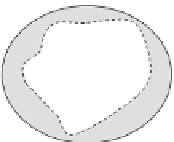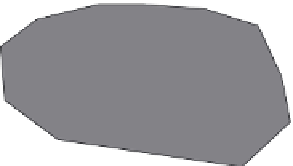Environmental Engineering Reference
In-Depth Information
Source control—active mines
Deny exposure to O
2
and H
2
O to debris
piles and exposed pyrite in mine site
Pyrite,
FeS
2
Exposure to oxygen
and water
Release of acidic iron and sulfate-rich
fluid into the geoenvironment
Source controls
Surface hydrological and
drainage controls
Drainage basin management
Water barrier systems
Receiving waters
Flora and habitat
Surficial soils
Management
Drainage basin management
Fluid flow channelization
Mitigation and remediation
Water treatment facilities
Constructed wetlands
Permeable reactive barriers
FIGURE 5.13
Basic elements of source control and passive treatment procedures for AMD stressor mitigation.
was able to return due to the low bioavailability of the metals and possible interactions
between the metals.
5.5.2.2 Wetlands
Natural wetlands are areas of land with the water level close to the land surface, thus
maintaining saturated soil conditions and vegetation that includes plants, peat, wildlife,
microbial cultures, cattails (
Ty p h a
spp.), reeds (
Phragmites
spp.), sedges (
Carex
spp.), bul-
rushes (
Scirpus
spp.), rushes (
Juncus,
spp.), water hyacinthe (
Eichhornia crassipes
), duckweeds
(
Lemna
spp.), grasses, and others (Mulligan, 2002). Algae and mosses, together with the wet
areas can trap the heavy metals. Constructed wetlands have been speciically designed to
include these species for the removal of BOD, suspended solids, nutrients, and heavy met-
als for optimal performance. It has been reported by Reed et al. (1995) that 1000 managed
wetlands are in operation throughout the world. In 1988, 142 North American wetland
systems were used for acid-mine drainage (Wieder, 1989).
Iron and manganese removal are often the key objectives in treatment of mine drainage.
Because of possible clogging of subsurface systems due to precipitation of iron and man-
ganese in subsurface systems, preference is usually given to surface systems since they
can be aerated more eficiently. Since the pH typically decreases from 6 to 3 in AMD phe-
nomena, the Tennessee Valley Authority (TVA) has developed an anoxic limestone drain
(ALD) for use as a treatment tool. This consists of a high calcium limestone aggregate

























Search WWH ::

Custom Search